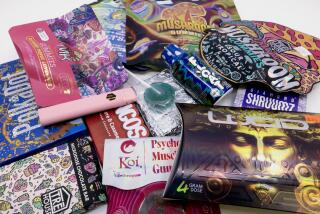Wine Family’s Sam Sebastiani Jr. Dies of Mushroom Poisoning
- Share via
Sam Sebastiani Jr., a member of the fourth generation of the pioneering California wine family, died Tuesday night of mushroom poisoning, one of nine cases of mushroom poisoning reported in the Bay Area this winter.
Sebastiani, 32, apparently consumed an Amanita phalloides, or “death cap,” mushroom while picnicking with friends near Santa Rosa on Jan. 5. No one else in the group was affected.
He was the son of Sam Sebastiani of Viansa Winery, and grandson and great-grandson, respectively, of August and Samuele Sebastiani, founders of the well-known Sebastiani Vineyards in Sonoma County. He was a nephew of former California Assemblyman Don Sebastiani, who ousted Sam Sebastiani Sr. from the presidency of Sebastiani Vineyards in 1986.
Sam Sebastiani Jr. was not associated with either winery at the time of his death.
Sebastiani’s is the latest of a wave of mushroom poisonings to hit Northern California in recent years. His was this year’s first fatality. Last year there were 13 cases, including the death of a farm worker who ate poisonous mushrooms in the Petaluma area.
Experts say the death cap accounts for 95% of the fatal mushroom poisonings around the world. It attacks the intestinal tract, liver and other organs. The first symptoms are stomach pains and severe diarrhea; within two or three days, damage to the liver can result in coma and then death.
The death cap mushroom is not native to California and was not found here in any numbers until the 1960s. David Arora, one of the state’s leading mycologists, said it is theorized that the mushroom arrived on the roots of European cork oak trees imported to the Santa Cruz area in the 1950s.
Since then, the death cap has been steadily expanding its range, helped along recently by a string of rainy winters. It is commonly found among California live oak trees.
The death cap, which has a shiny, metallic green cap in maturity, is just as potent in its infancy, when it is all white. It does not closely resemble any edible mushroom, Arora said.
Arora said most mushroom poisonings are the result of one of three factors.
First, people move around more than ever and may not be familiar with the mushrooms in new areas.
“The second common cause obviously would be just plain ignorance, people who know nothing about mushrooms but pick them anyway,” Arora said. “The third cause is, even if people know something about mushrooms, sometimes they just use poor judgment.
“They see a mushroom and think to themselves, ‘I know that’s not the same as the mushroom I’m looking for, but it looks kind of like it,’ and they eat it anyway.”
More to Read
Sign up for Essential California
The most important California stories and recommendations in your inbox every morning.
You may occasionally receive promotional content from the Los Angeles Times.











